Information System Report: High Sugar Consumption and Health Issues
VerifiedAdded on 2023/06/06
|10
|1774
|77
Report
AI Summary
This information system report delves into the detrimental health consequences of excessive sugar consumption, focusing on obesity and Type 2 diabetes. The report highlights the increasing prevalence of these conditions due to the widespread intake of sugary foods and beverages. It explores the underlying mechanisms by which high sugar intake contributes to weight gain, insulin resistance, and the development of Type 2 diabetes. Furthermore, the report examines potential solutions, including lifestyle modifications such as dietary changes and increased physical activity, as well as policy interventions like taxes on sugary products and regulations on food manufacturing. The report emphasizes the need for a multi-faceted approach to address the growing health crisis associated with high sugar consumption, advocating for both individual behavioral changes and systemic policy reforms to improve public health.

Running Head: INFORMATION SYSTEM
Information System
Name
Institution
Information System
Name
Institution
Paraphrase This Document
Need a fresh take? Get an instant paraphrase of this document with our AI Paraphraser
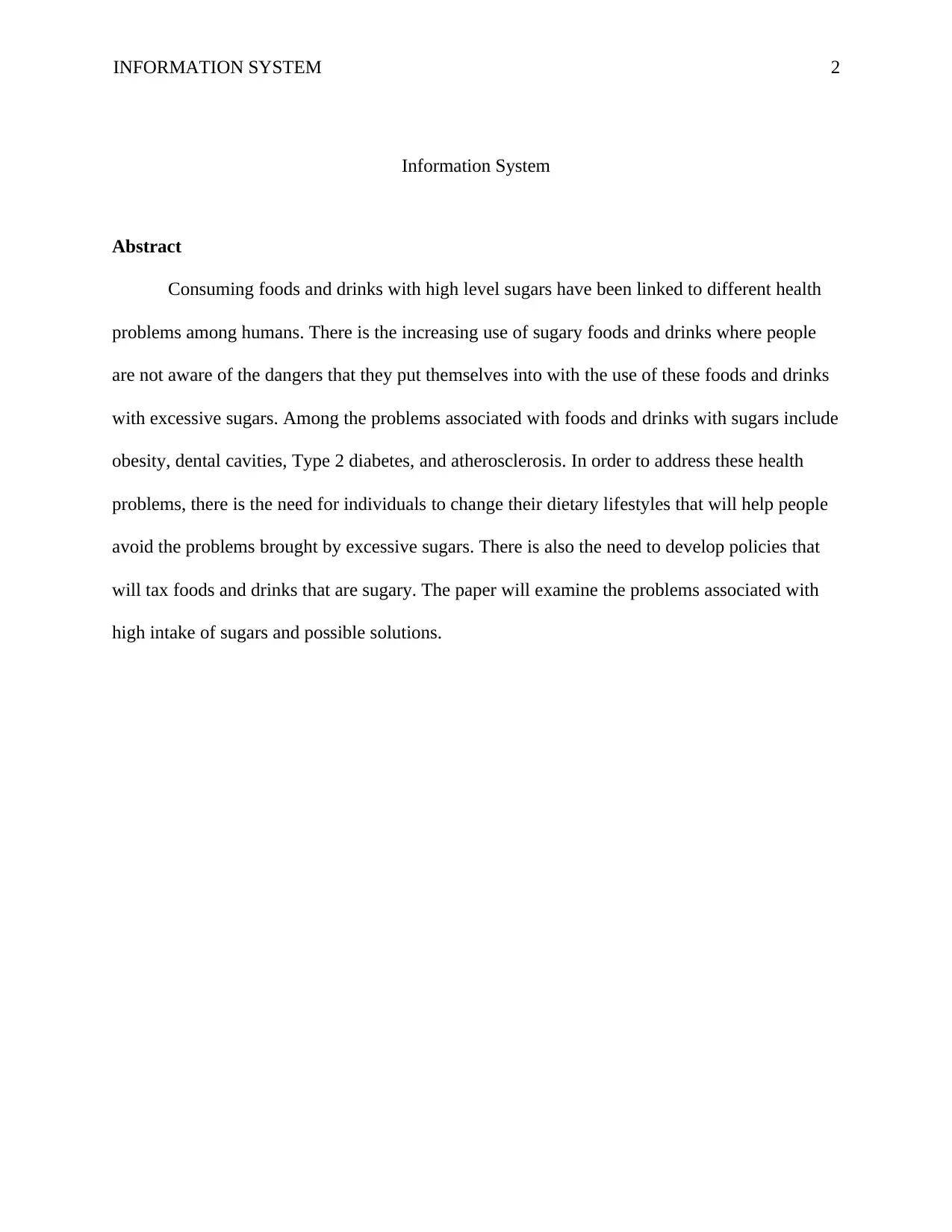
INFORMATION SYSTEM 2
Information System
Abstract
Consuming foods and drinks with high level sugars have been linked to different health
problems among humans. There is the increasing use of sugary foods and drinks where people
are not aware of the dangers that they put themselves into with the use of these foods and drinks
with excessive sugars. Among the problems associated with foods and drinks with sugars include
obesity, dental cavities, Type 2 diabetes, and atherosclerosis. In order to address these health
problems, there is the need for individuals to change their dietary lifestyles that will help people
avoid the problems brought by excessive sugars. There is also the need to develop policies that
will tax foods and drinks that are sugary. The paper will examine the problems associated with
high intake of sugars and possible solutions.
Information System
Abstract
Consuming foods and drinks with high level sugars have been linked to different health
problems among humans. There is the increasing use of sugary foods and drinks where people
are not aware of the dangers that they put themselves into with the use of these foods and drinks
with excessive sugars. Among the problems associated with foods and drinks with sugars include
obesity, dental cavities, Type 2 diabetes, and atherosclerosis. In order to address these health
problems, there is the need for individuals to change their dietary lifestyles that will help people
avoid the problems brought by excessive sugars. There is also the need to develop policies that
will tax foods and drinks that are sugary. The paper will examine the problems associated with
high intake of sugars and possible solutions.
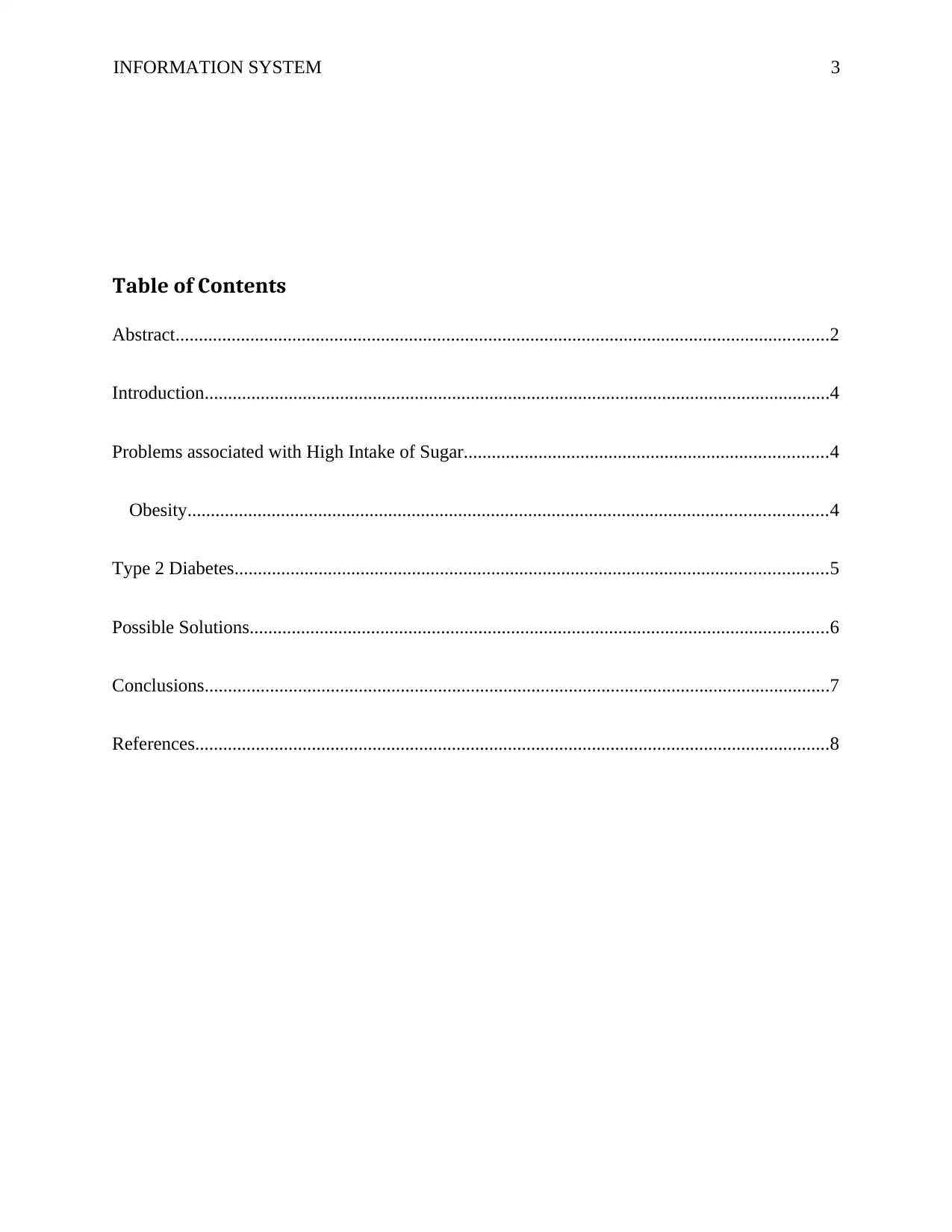
INFORMATION SYSTEM 3
Table of Contents
Abstract............................................................................................................................................2
Introduction......................................................................................................................................4
Problems associated with High Intake of Sugar..............................................................................4
Obesity.........................................................................................................................................4
Type 2 Diabetes...............................................................................................................................5
Possible Solutions............................................................................................................................6
Conclusions......................................................................................................................................7
References........................................................................................................................................8
Table of Contents
Abstract............................................................................................................................................2
Introduction......................................................................................................................................4
Problems associated with High Intake of Sugar..............................................................................4
Obesity.........................................................................................................................................4
Type 2 Diabetes...............................................................................................................................5
Possible Solutions............................................................................................................................6
Conclusions......................................................................................................................................7
References........................................................................................................................................8
⊘ This is a preview!⊘
Do you want full access?
Subscribe today to unlock all pages.

Trusted by 1+ million students worldwide
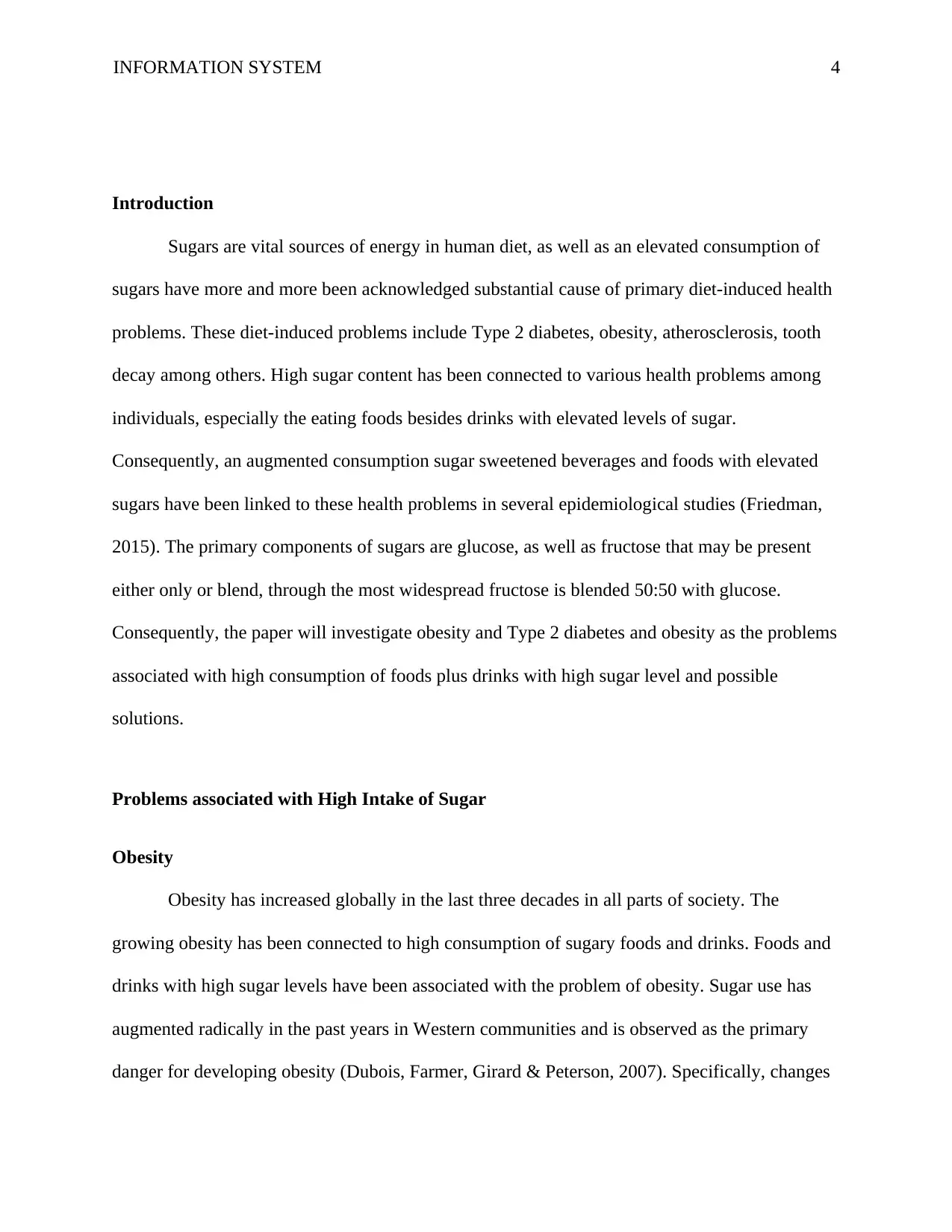
INFORMATION SYSTEM 4
Introduction
Sugars are vital sources of energy in human diet, as well as an elevated consumption of
sugars have more and more been acknowledged substantial cause of primary diet-induced health
problems. These diet-induced problems include Type 2 diabetes, obesity, atherosclerosis, tooth
decay among others. High sugar content has been connected to various health problems among
individuals, especially the eating foods besides drinks with elevated levels of sugar.
Consequently, an augmented consumption sugar sweetened beverages and foods with elevated
sugars have been linked to these health problems in several epidemiological studies (Friedman,
2015). The primary components of sugars are glucose, as well as fructose that may be present
either only or blend, through the most widespread fructose is blended 50:50 with glucose.
Consequently, the paper will investigate obesity and Type 2 diabetes and obesity as the problems
associated with high consumption of foods plus drinks with high sugar level and possible
solutions.
Problems associated with High Intake of Sugar
Obesity
Obesity has increased globally in the last three decades in all parts of society. The
growing obesity has been connected to high consumption of sugary foods and drinks. Foods and
drinks with high sugar levels have been associated with the problem of obesity. Sugar use has
augmented radically in the past years in Western communities and is observed as the primary
danger for developing obesity (Dubois, Farmer, Girard & Peterson, 2007). Specifically, changes
Introduction
Sugars are vital sources of energy in human diet, as well as an elevated consumption of
sugars have more and more been acknowledged substantial cause of primary diet-induced health
problems. These diet-induced problems include Type 2 diabetes, obesity, atherosclerosis, tooth
decay among others. High sugar content has been connected to various health problems among
individuals, especially the eating foods besides drinks with elevated levels of sugar.
Consequently, an augmented consumption sugar sweetened beverages and foods with elevated
sugars have been linked to these health problems in several epidemiological studies (Friedman,
2015). The primary components of sugars are glucose, as well as fructose that may be present
either only or blend, through the most widespread fructose is blended 50:50 with glucose.
Consequently, the paper will investigate obesity and Type 2 diabetes and obesity as the problems
associated with high consumption of foods plus drinks with high sugar level and possible
solutions.
Problems associated with High Intake of Sugar
Obesity
Obesity has increased globally in the last three decades in all parts of society. The
growing obesity has been connected to high consumption of sugary foods and drinks. Foods and
drinks with high sugar levels have been associated with the problem of obesity. Sugar use has
augmented radically in the past years in Western communities and is observed as the primary
danger for developing obesity (Dubois, Farmer, Girard & Peterson, 2007). Specifically, changes
Paraphrase This Document
Need a fresh take? Get an instant paraphrase of this document with our AI Paraphraser
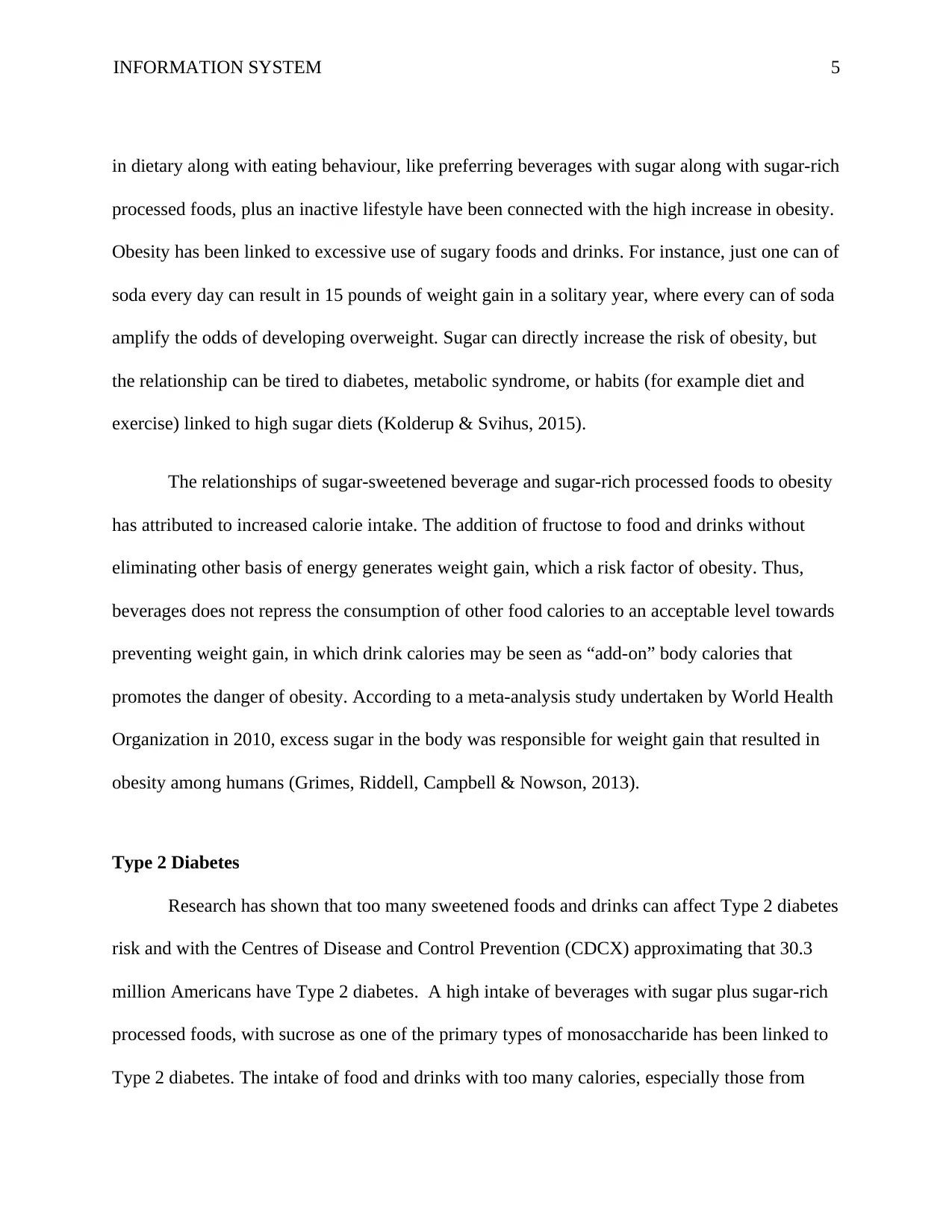
INFORMATION SYSTEM 5
in dietary along with eating behaviour, like preferring beverages with sugar along with sugar-rich
processed foods, plus an inactive lifestyle have been connected with the high increase in obesity.
Obesity has been linked to excessive use of sugary foods and drinks. For instance, just one can of
soda every day can result in 15 pounds of weight gain in a solitary year, where every can of soda
amplify the odds of developing overweight. Sugar can directly increase the risk of obesity, but
the relationship can be tired to diabetes, metabolic syndrome, or habits (for example diet and
exercise) linked to high sugar diets (Kolderup & Svihus, 2015).
The relationships of sugar-sweetened beverage and sugar-rich processed foods to obesity
has attributed to increased calorie intake. The addition of fructose to food and drinks without
eliminating other basis of energy generates weight gain, which a risk factor of obesity. Thus,
beverages does not repress the consumption of other food calories to an acceptable level towards
preventing weight gain, in which drink calories may be seen as “add-on” body calories that
promotes the danger of obesity. According to a meta-analysis study undertaken by World Health
Organization in 2010, excess sugar in the body was responsible for weight gain that resulted in
obesity among humans (Grimes, Riddell, Campbell & Nowson, 2013).
Type 2 Diabetes
Research has shown that too many sweetened foods and drinks can affect Type 2 diabetes
risk and with the Centres of Disease and Control Prevention (CDCX) approximating that 30.3
million Americans have Type 2 diabetes. A high intake of beverages with sugar plus sugar-rich
processed foods, with sucrose as one of the primary types of monosaccharide has been linked to
Type 2 diabetes. The intake of food and drinks with too many calories, especially those from
in dietary along with eating behaviour, like preferring beverages with sugar along with sugar-rich
processed foods, plus an inactive lifestyle have been connected with the high increase in obesity.
Obesity has been linked to excessive use of sugary foods and drinks. For instance, just one can of
soda every day can result in 15 pounds of weight gain in a solitary year, where every can of soda
amplify the odds of developing overweight. Sugar can directly increase the risk of obesity, but
the relationship can be tired to diabetes, metabolic syndrome, or habits (for example diet and
exercise) linked to high sugar diets (Kolderup & Svihus, 2015).
The relationships of sugar-sweetened beverage and sugar-rich processed foods to obesity
has attributed to increased calorie intake. The addition of fructose to food and drinks without
eliminating other basis of energy generates weight gain, which a risk factor of obesity. Thus,
beverages does not repress the consumption of other food calories to an acceptable level towards
preventing weight gain, in which drink calories may be seen as “add-on” body calories that
promotes the danger of obesity. According to a meta-analysis study undertaken by World Health
Organization in 2010, excess sugar in the body was responsible for weight gain that resulted in
obesity among humans (Grimes, Riddell, Campbell & Nowson, 2013).
Type 2 Diabetes
Research has shown that too many sweetened foods and drinks can affect Type 2 diabetes
risk and with the Centres of Disease and Control Prevention (CDCX) approximating that 30.3
million Americans have Type 2 diabetes. A high intake of beverages with sugar plus sugar-rich
processed foods, with sucrose as one of the primary types of monosaccharide has been linked to
Type 2 diabetes. The intake of food and drinks with too many calories, especially those from
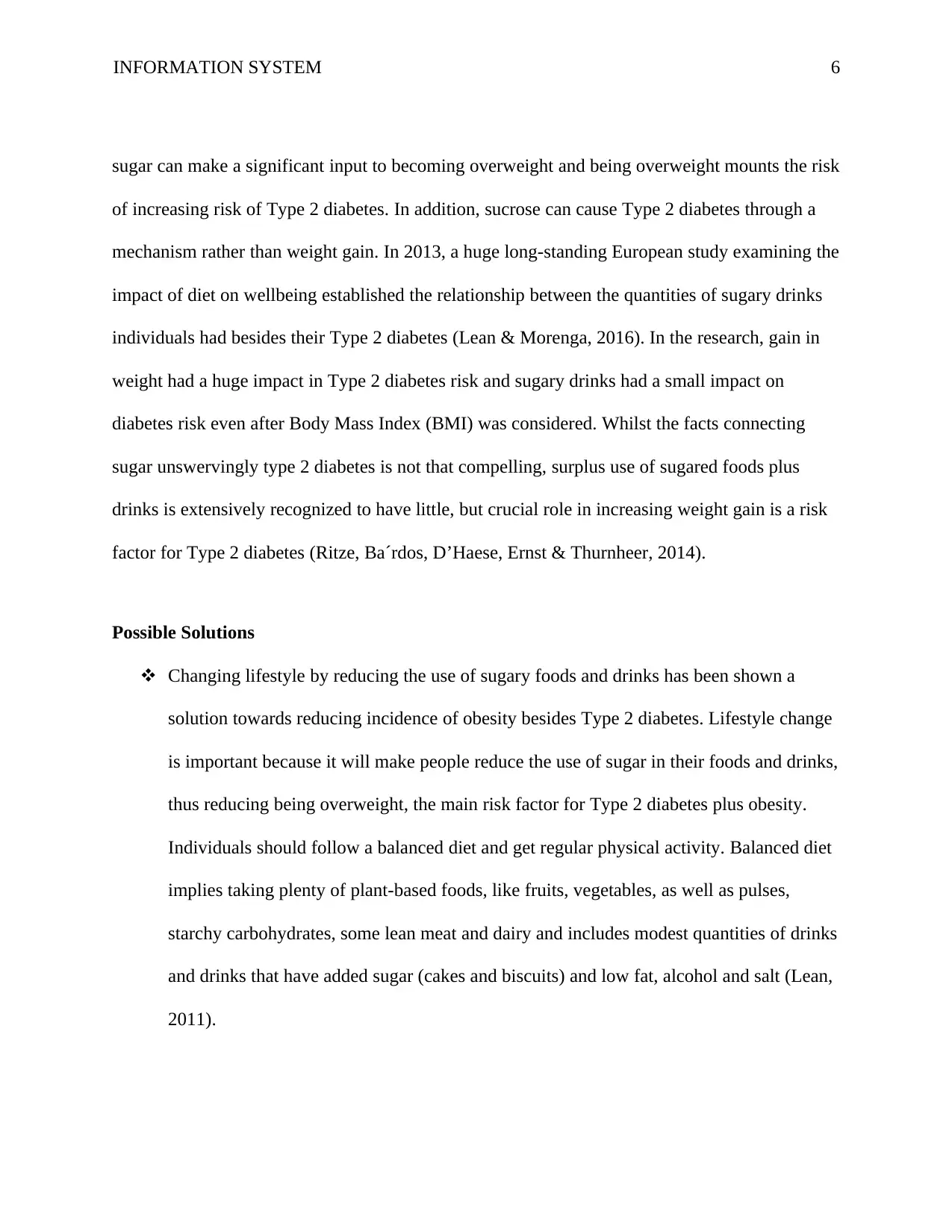
INFORMATION SYSTEM 6
sugar can make a significant input to becoming overweight and being overweight mounts the risk
of increasing risk of Type 2 diabetes. In addition, sucrose can cause Type 2 diabetes through a
mechanism rather than weight gain. In 2013, a huge long-standing European study examining the
impact of diet on wellbeing established the relationship between the quantities of sugary drinks
individuals had besides their Type 2 diabetes (Lean & Morenga, 2016). In the research, gain in
weight had a huge impact in Type 2 diabetes risk and sugary drinks had a small impact on
diabetes risk even after Body Mass Index (BMI) was considered. Whilst the facts connecting
sugar unswervingly type 2 diabetes is not that compelling, surplus use of sugared foods plus
drinks is extensively recognized to have little, but crucial role in increasing weight gain is a risk
factor for Type 2 diabetes (Ritze, Ba´rdos, D’Haese, Ernst & Thurnheer, 2014).
Possible Solutions
Changing lifestyle by reducing the use of sugary foods and drinks has been shown a
solution towards reducing incidence of obesity besides Type 2 diabetes. Lifestyle change
is important because it will make people reduce the use of sugar in their foods and drinks,
thus reducing being overweight, the main risk factor for Type 2 diabetes plus obesity.
Individuals should follow a balanced diet and get regular physical activity. Balanced diet
implies taking plenty of plant-based foods, like fruits, vegetables, as well as pulses,
starchy carbohydrates, some lean meat and dairy and includes modest quantities of drinks
and drinks that have added sugar (cakes and biscuits) and low fat, alcohol and salt (Lean,
2011).
sugar can make a significant input to becoming overweight and being overweight mounts the risk
of increasing risk of Type 2 diabetes. In addition, sucrose can cause Type 2 diabetes through a
mechanism rather than weight gain. In 2013, a huge long-standing European study examining the
impact of diet on wellbeing established the relationship between the quantities of sugary drinks
individuals had besides their Type 2 diabetes (Lean & Morenga, 2016). In the research, gain in
weight had a huge impact in Type 2 diabetes risk and sugary drinks had a small impact on
diabetes risk even after Body Mass Index (BMI) was considered. Whilst the facts connecting
sugar unswervingly type 2 diabetes is not that compelling, surplus use of sugared foods plus
drinks is extensively recognized to have little, but crucial role in increasing weight gain is a risk
factor for Type 2 diabetes (Ritze, Ba´rdos, D’Haese, Ernst & Thurnheer, 2014).
Possible Solutions
Changing lifestyle by reducing the use of sugary foods and drinks has been shown a
solution towards reducing incidence of obesity besides Type 2 diabetes. Lifestyle change
is important because it will make people reduce the use of sugar in their foods and drinks,
thus reducing being overweight, the main risk factor for Type 2 diabetes plus obesity.
Individuals should follow a balanced diet and get regular physical activity. Balanced diet
implies taking plenty of plant-based foods, like fruits, vegetables, as well as pulses,
starchy carbohydrates, some lean meat and dairy and includes modest quantities of drinks
and drinks that have added sugar (cakes and biscuits) and low fat, alcohol and salt (Lean,
2011).
⊘ This is a preview!⊘
Do you want full access?
Subscribe today to unlock all pages.

Trusted by 1+ million students worldwide

INFORMATION SYSTEM 7
Policies should developed by the governments to ensure that the food and beverage
industry manufactures foods and drinks with minimal sugars to reduce prevalence of
obesity plus Type 2 diabetes. Thus, the manufactures should be made through policies to
reduce the amount of sugar that is added to foods that are processed and sugar-sweetened
beverages. For instance, a target through policy can be set where the sugar added to food
and soft drinks reduced to 20-30% by the food industry in the next 3-5 years. This is
achievable because it will significantly lead to reduction in calorie consumption of
around 100Kcal (420KJ) in a day for everyone and more in those individuals who are
specifically vulnerable to obesity and Type 2 diabetes (Kolderup & Svihus, 2015).
There is the need to introduce tax on sugary foods and drinks designed to lower obesity
and Type 2 diabetes. This will be contained in fiscal policies that result in at least 20%
increase in the retail price of sugary drinks and foods that will lead to a sharp decline in
the consumption of these products. This has been implemented in Mexico through “sugar
wall” bill through placing high taxes on non-essential sugar sweetened products (Lee &
Giannobile, 2016).
Conclusions
Obesity and Type 2 diabetes have found to be caused by overweight as the leading risk
factor because increased intake of foods and drinks with high sugar level. This has become a
problem around the world and there is the need to develop approaches to address this growing
problem. Thus, there is the need to modify the dietary lifestyles and introduce policies that target
manufactures and introduce high taxes to reduce the consumption of sugary foods and drinks.
Policies should developed by the governments to ensure that the food and beverage
industry manufactures foods and drinks with minimal sugars to reduce prevalence of
obesity plus Type 2 diabetes. Thus, the manufactures should be made through policies to
reduce the amount of sugar that is added to foods that are processed and sugar-sweetened
beverages. For instance, a target through policy can be set where the sugar added to food
and soft drinks reduced to 20-30% by the food industry in the next 3-5 years. This is
achievable because it will significantly lead to reduction in calorie consumption of
around 100Kcal (420KJ) in a day for everyone and more in those individuals who are
specifically vulnerable to obesity and Type 2 diabetes (Kolderup & Svihus, 2015).
There is the need to introduce tax on sugary foods and drinks designed to lower obesity
and Type 2 diabetes. This will be contained in fiscal policies that result in at least 20%
increase in the retail price of sugary drinks and foods that will lead to a sharp decline in
the consumption of these products. This has been implemented in Mexico through “sugar
wall” bill through placing high taxes on non-essential sugar sweetened products (Lee &
Giannobile, 2016).
Conclusions
Obesity and Type 2 diabetes have found to be caused by overweight as the leading risk
factor because increased intake of foods and drinks with high sugar level. This has become a
problem around the world and there is the need to develop approaches to address this growing
problem. Thus, there is the need to modify the dietary lifestyles and introduce policies that target
manufactures and introduce high taxes to reduce the consumption of sugary foods and drinks.
Paraphrase This Document
Need a fresh take? Get an instant paraphrase of this document with our AI Paraphraser
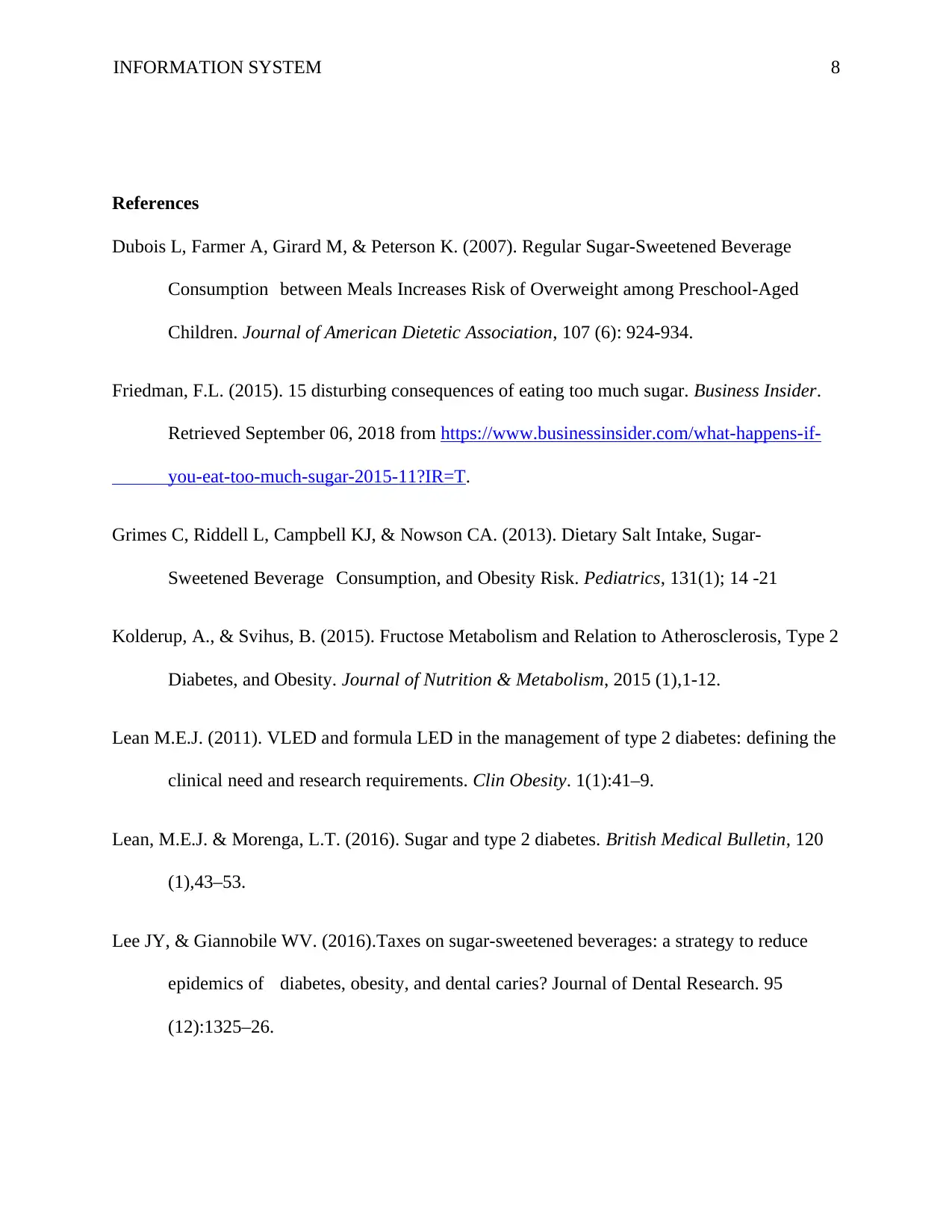
INFORMATION SYSTEM 8
References
Dubois L, Farmer A, Girard M, & Peterson K. (2007). Regular Sugar-Sweetened Beverage
Consumption between Meals Increases Risk of Overweight among Preschool-Aged
Children. Journal of American Dietetic Association, 107 (6): 924-934.
Friedman, F.L. (2015). 15 disturbing consequences of eating too much sugar. Business Insider.
Retrieved September 06, 2018 from https://www.businessinsider.com/what-happens-if-
you-eat-too-much-sugar-2015-11?IR=T.
Grimes C, Riddell L, Campbell KJ, & Nowson CA. (2013). Dietary Salt Intake, Sugar-
Sweetened Beverage Consumption, and Obesity Risk. Pediatrics, 131(1); 14 -21
Kolderup, A., & Svihus, B. (2015). Fructose Metabolism and Relation to Atherosclerosis, Type 2
Diabetes, and Obesity. Journal of Nutrition & Metabolism, 2015 (1),1-12.
Lean M.E.J. (2011). VLED and formula LED in the management of type 2 diabetes: defining the
clinical need and research requirements. Clin Obesity. 1(1):41–9.
Lean, M.E.J. & Morenga, L.T. (2016). Sugar and type 2 diabetes. British Medical Bulletin, 120
(1),43–53.
Lee JY, & Giannobile WV. (2016).Taxes on sugar-sweetened beverages: a strategy to reduce
epidemics of diabetes, obesity, and dental caries? Journal of Dental Research. 95
(12):1325–26.
References
Dubois L, Farmer A, Girard M, & Peterson K. (2007). Regular Sugar-Sweetened Beverage
Consumption between Meals Increases Risk of Overweight among Preschool-Aged
Children. Journal of American Dietetic Association, 107 (6): 924-934.
Friedman, F.L. (2015). 15 disturbing consequences of eating too much sugar. Business Insider.
Retrieved September 06, 2018 from https://www.businessinsider.com/what-happens-if-
you-eat-too-much-sugar-2015-11?IR=T.
Grimes C, Riddell L, Campbell KJ, & Nowson CA. (2013). Dietary Salt Intake, Sugar-
Sweetened Beverage Consumption, and Obesity Risk. Pediatrics, 131(1); 14 -21
Kolderup, A., & Svihus, B. (2015). Fructose Metabolism and Relation to Atherosclerosis, Type 2
Diabetes, and Obesity. Journal of Nutrition & Metabolism, 2015 (1),1-12.
Lean M.E.J. (2011). VLED and formula LED in the management of type 2 diabetes: defining the
clinical need and research requirements. Clin Obesity. 1(1):41–9.
Lean, M.E.J. & Morenga, L.T. (2016). Sugar and type 2 diabetes. British Medical Bulletin, 120
(1),43–53.
Lee JY, & Giannobile WV. (2016).Taxes on sugar-sweetened beverages: a strategy to reduce
epidemics of diabetes, obesity, and dental caries? Journal of Dental Research. 95
(12):1325–26.
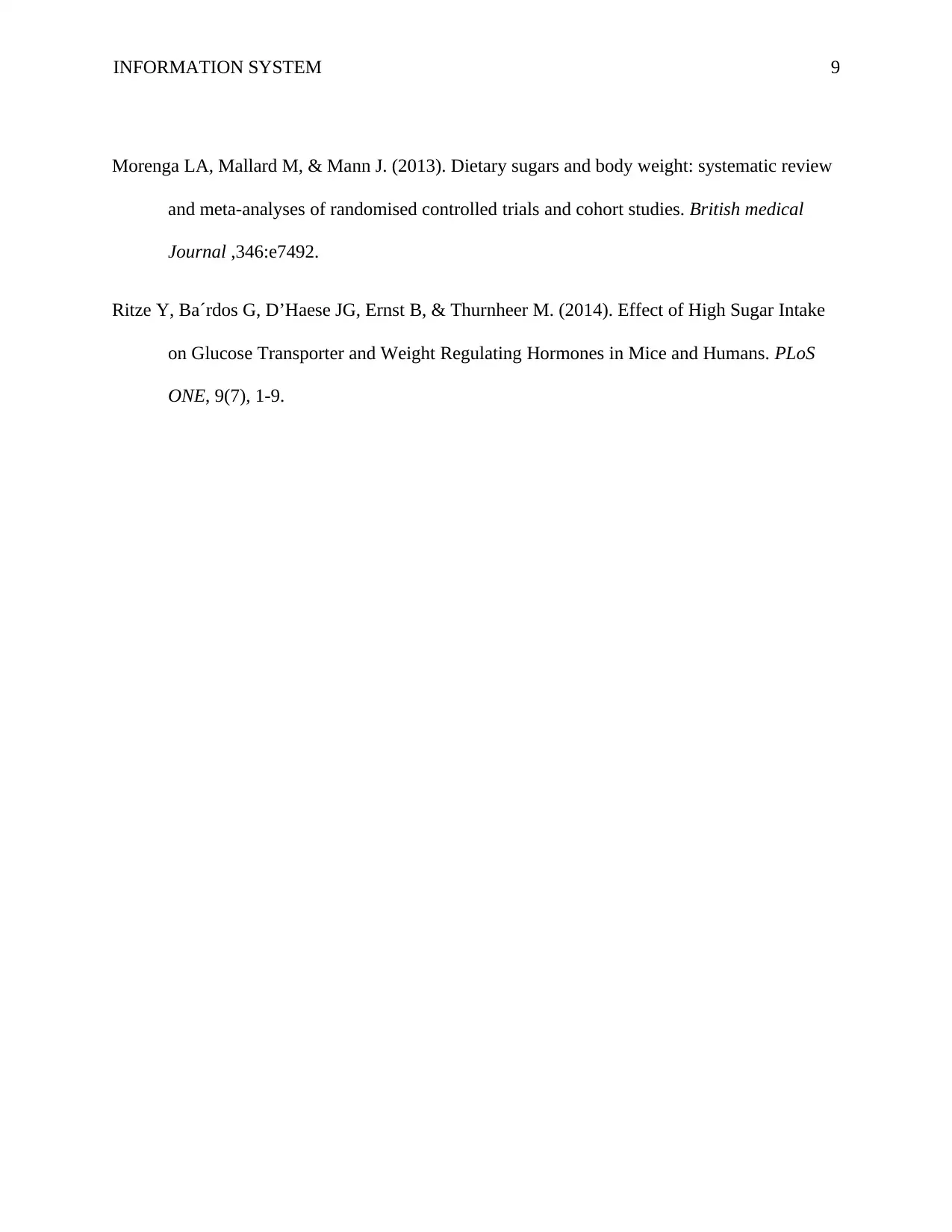
INFORMATION SYSTEM 9
Morenga LA, Mallard M, & Mann J. (2013). Dietary sugars and body weight: systematic review
and meta-analyses of randomised controlled trials and cohort studies. British medical
Journal ,346:e7492.
Ritze Y, Ba´rdos G, D’Haese JG, Ernst B, & Thurnheer M. (2014). Effect of High Sugar Intake
on Glucose Transporter and Weight Regulating Hormones in Mice and Humans. PLoS
ONE, 9(7), 1-9.
Morenga LA, Mallard M, & Mann J. (2013). Dietary sugars and body weight: systematic review
and meta-analyses of randomised controlled trials and cohort studies. British medical
Journal ,346:e7492.
Ritze Y, Ba´rdos G, D’Haese JG, Ernst B, & Thurnheer M. (2014). Effect of High Sugar Intake
on Glucose Transporter and Weight Regulating Hormones in Mice and Humans. PLoS
ONE, 9(7), 1-9.
⊘ This is a preview!⊘
Do you want full access?
Subscribe today to unlock all pages.

Trusted by 1+ million students worldwide

INFORMATION SYSTEM
10
10
1 out of 10
Related Documents
Your All-in-One AI-Powered Toolkit for Academic Success.
+13062052269
info@desklib.com
Available 24*7 on WhatsApp / Email
![[object Object]](/_next/static/media/star-bottom.7253800d.svg)
Unlock your academic potential
Copyright © 2020–2025 A2Z Services. All Rights Reserved. Developed and managed by ZUCOL.





